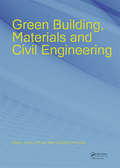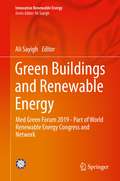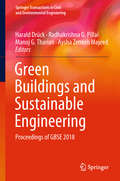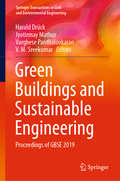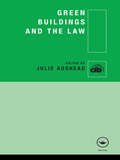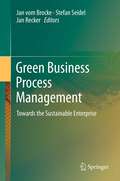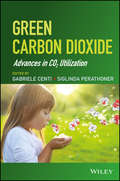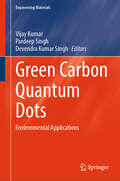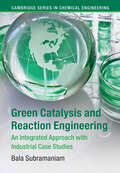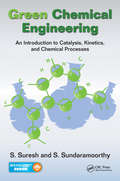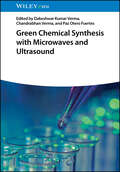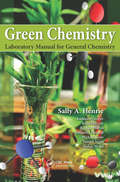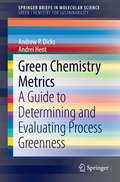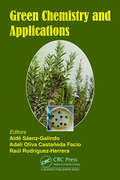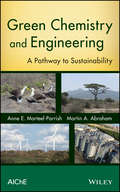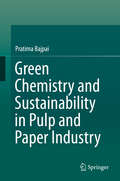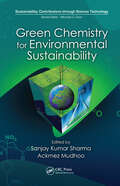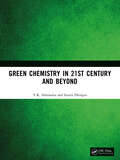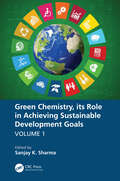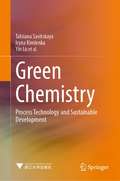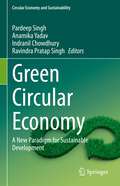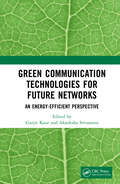- Table View
- List View
Green Building, Materials and Civil Engineering
by Ran Chen Jimmy C.M. Kao Wen-Pei SungThis book contains select green building, materials, and civil engineering papers from the 4th International Conference on Green Building, Materials and Civil Engineering (GBMCE), which was held in Hong Kong, August 21-22, 2014. This volume of proceedings aims to provide a platform for researchers, engineers, academics, and industry professionals f
Green Building: Principles and Practices in Residential Construction
by Abe Kruger Carl SevilleGREEN BUILDING: PRINCIPLES AND PRACTICES IN RESIDENTIAL CONSTRUCTION provides a current, comprehensive guide to this exciting, emerging field. From core concepts to innovative applications of cutting-edge technology and the latest industry trends, this text offers an in-depth introduction to the construction of "green" homes. Unlike many texts that adopt a product-oriented approach, this book emphasizes the crucial planning, processes, and execution methods necessary for effective, environmentally sound construction. This text demonstrates that Earth-friendly products and energy-efficient materials take planning in order to make a building truly green. This visionary text helps students and professionals develop the knowledge and skills to "think green" from start to finish, empowering and inspiring them to build truly sustainable homes.
Green Buildings and Renewable Energy: Med Green Forum 2019 - Part of World Renewable Energy Congress and Network (Innovative Renewable Energy)
by Ali SayighThis book highlights selected papers presented during the bi-annual World Renewable Energy Network’s 2019 Med Green Forum. This international forum highlights the importance of growing renewable energy applications in two main sectors: Electricity Generation and Sustainable Building. The papers highlight the most current research and technological breakthroughs illustrating the viability of using renewable energy to satisfy energy needs. Coverage includes a broad range of renewable energy technologies and applications in all sectors – electricity production, heating and cooling, agricultural applications, water desalination, industrial applications, and transport. Presents leading-edge research in green building, sustainable architecture, and renewable energy;Covers a broad range of renewable energy technologies and applications in all sectors;Contains case studies and examples to enhance practical application of the technologies presented.
Green Buildings and Sustainable Engineering: Proceedings of GBSE 2018 (Springer Transactions in Civil and Environmental Engineering)
by Harald Drück Radhakrishna G. Pillai Manoj G Tharian Aysha Zeneeb MajeedThis book comprises the proceedings of the International Conference on Green Buildings and Sustainable Engineering (GBSE 2018), which focused on the theme “Transforming our Built Environment through Innovation and Integration towards a Smart and Sustainable Future”. The papers included address all aspects of green buildings and sustainability practices in civil engineering, and offer a valuable reference resource for researchers, practitioners, and policy makers.
Green Buildings and Sustainable Engineering: Proceedings of GBSE 2019 (Springer Transactions in Civil and Environmental Engineering)
by Jyotirmay Mathur Harald Drück Varghese Panthalookaran V. M. SreekumarThis book comprises the proceedings of the International Conference on Green Buildings and Sustainable Engineering (GBSE 2019), which focused on the theme “Ecotechnological and Digital Solutions for Smart Cities”. The papers included address all aspects of green buildings and sustainability practices in civil engineering, and focus on ways and means of reducing pollution and degradation of the environment through efficient usage of energy and water. The book will prove a valuable reference resource for researchers, practitioners, and policy makers.
Green Buildings and the Law
by Julie AdsheadIn countries such as the UK, the energy used in constructing, occupying and operating buildings represents approximately fifty percent of greenhouse gas emissions. Pressure to improve the environmental performance of buildings during both construction and occupancy, particularly to reduce carbon emissions from buildings, has become intense. Understandably, legislation and regulation are driving green development and compliance. And this is happening in a wide variety of ways. This review of the law in key jurisdictions for the research community, lawyers, the construction industry and government examines some of the mechanisms in place – from the more traditional building regulation controls to green leases and the law relating to buildings and their natural environment. Members of the CIB TG69 research group on ‘Green Buildings and the Law’ review aspects of the law relating to green development in a range of jurisdictions.
Green Business Process Management
by Jan Vom Brocke Jan Recker Stefan SeidelGreen Business Process Management - Towards the Sustainable Enterprise" consolidates the global state-of-the-art knowledge about how business processes can be managed and improved in light of sustainability objectives. Business organizations, a dominant part of our society, have always been a major contributor to the degradation of our natural environment, through the resource consumption, greenhouse emissions, and wastage production associated with their business processes. In order to lessen their impact on the natural environment, organizations must design and implement environmentally sustainable business processes. Finding solutions to this organizational design problem is the key challenge of Green Business Process Management. This book- discusses the emerging challenges of designing "green" business processes,- presents tools and methods that organizations can use in order to design and implement environmentally sustainable processes, and- provides insights from cases where organizations successfully engaged in more sustainable business practices. The book is of relevance to both practitioners and academics who are interested in understanding, designing, and implementing "green" business processes. It also constitutes a valuable resource for students and lecturers in the fields of information systems, management, and sustainable development. Preface by Richard T. Watson
Green Carbon Dioxide
by Siglinda Perathoner Gabriele CentiPROMISING NEW APPROACHES TO RECYCLE CARBON DIOXIDE AND REDUCE EMISSIONSWith this book as their guide, readers will learn a variety of new approaches and methods to recycle and reuse carbon dioxide (CO2) in order to produce green fuels and chemicals and, at the same time, minimize CO2 emissions. The authors demonstrate how to convert CO2 into a broad range of essential products by using alternative green energy sources, such as solar, wind, and hydro-power as well as sustainable energy sources. Readers will discover that CO2 can be a driving force for the sustainable future of both the chemical industry and the energy and fuels industry.Green Carbon Dioxide features a team of expert authors, offering perspectives on the latest breakthroughs in CO2 recycling from Asia, Europe, and North America. The book begins with an introduction to the production of CO2-based fuels and chemicals. Next, it covers such topics as:Transformation of CO2 to useable products through free-radical-induced reactionsHydrogenation of CO2 to liquid fuelsDirect synthesis of organic carbonates from CO2 and alcohols using heterogeneous oxide catalystsElectrocatalytic reduction of CO2 in methanol mediumFuel production from photocatalytic reduction of CO2 with water using TiO2-based nanocompositesUse of CO2 in enhanced oil recovery and carbon capture and sequestration More than 1,000 references enable readers to explore individual topics in greater depth.Green Carbon Dioxide offers engineers, chemists, and managers in the chemical and energy and fuel industries a remarkable new perspective, demonstrating how CO2 can play a significant role in the development of a sustainable Earth.
Green Carbon Quantum Dots: Environmental Applications (Engineering Materials)
by Vijay Kumar Pardeep Singh Devendra Kumar SinghThis book highlights the environmental applications of plant-mediated carbon quantum dots, i.e., detection of heavy metals, sensing of toxic organic compounds, degradation of dyes and other toxic compounds, antioxidant activity, antimicrobial activity, detection of drugs, etc. This book presents the chemistry and mechanism behind the synthesis and various environmental applications of QDs. This book is beneficial for researchers, professionals and students working in the fields of environmental sciences, material engineering, electronics, chemical engineering, biochemical and biomedical engineering, etc. It will be also useful in specialized courses in nanotechnology, green synthesis, Environmental Science & Engineering.
Green Catalysis and Reaction Engineering: An Integrated Approach with Industrial Case Studies (Cambridge Series in Chemical Engineering)
by Bala SubramaniamDiscover tools to perform Life Cycle Analysis (LCA) and develop sustainable chemical technologies in this valuable guide for chemists, engineers and practitioners. Tackling one of the key challenges of modern industrial chemical engineering, this book introduces tools to assess the environmental footprint and economics of key chemical processes that make the ingredients of everyday products such as plastics, synthetic fibers, detergents and fuels. Describing diverse industrial processes in detail, it provides process flow diagrams including raw material sourcing, catalytic reactors, separation units, process equipment and recycle streams. The book clearly explains elements of LCA and how various software tools, available in the public domain and commercially, can be used to perform LCA. Supported by real-world practical examples and case studies provided by industrial and academic chemists and chemical engineers, this is an essential tool for readers involved in implementing LCA, and developing next-generation sustainable chemical technologies.
Green Chemical Engineering: An Introduction to Catalysis, Kinetics, and Chemical Processes
by S. Suresh S. SundaramoorthyWhile chemical products are useful in their own right-they address the demands and needs of the masses-they also drain our natural resources and generate unwanted pollution. Green Chemical Engineering: An Introduction to Catalysis, Kinetics, and Chemical Processes encourages minimized use of non-renewable natural resources and fosters maximized pol
Green Chemical Synthesis with Microwaves and Ultrasound
by Chandrabhan Verma Dakeshwar Kumar Verma Paz Otero FuertesGreen Chemical Synthesis with Microwaves and Ultrasound A guide to the efficient and sustainable synthesis of organic compounds Chemical processes and the synthesis of compounds are essential aspects of numerous industries, and particularly central to the creation of drug-like structures. Their often significant environmental biproducts, however, have driven substantial innovations in the areas of green and organic synthesis, which have the potential to drive efficient, solvent-free synthesis and create more sustainable chemical processes. The use of microwaves and ultrasounds in chemical synthesis has proven an especially fruitful area of research, with the potential to produce a more sustainable industrial future. Green Chemical Synthesis with Microwaves and Ultrasound provides a comprehensive overview of recent advances in microwave- and ultrasound-driven synthesis and their cutting-edge applications. Green Chemical Synthesis with Microwaves and Ultrasound readers will also find: Introduction to the key equipment and tools of green chemical synthesis Detailed discussion of methods including ultrasound irradiation, metal-catalyzed reactions, enzymatic reactions, and many more An authorial team with immense experience in environmentally friendly organic chemical production Green Chemical Synthesis with Microwaves and Ultrasound is ideal for chemists, organic chemists, chemical engineers, biochemists, and any researchers or industry professionals working on the synthesis of chemicals and/or organic compounds.
Green Chemistry Laboratory Manual for General Chemistry
by Sally A. HenrieGreen chemistry involves designing novel ways to create and synthesize products and implement processes that will eliminate or greatly reduce negative environmental impacts. Providing educational laboratory materials that challenge students with the customary topics found in a general chemistry laboratory manual, this lab manual enables students to see how green chemistry principles can be applied to real-world issues. Following a consistent format, each lab experiment includes objectives, prelab questions, and detailed step-by-step procedures for performing the experiments. Additional questions encourage further research about how green chemistry principles compare with traditional, more hazardous experimental methods.
Green Chemistry Metrics
by Andrew P. Dicks Andrei HentThis contribution to SpringerBriefs in Green Chemistry outlines and discusses the four major green chemistry metrics (atom economy, reaction mass efficiency, E factor and process mass intensity), at a level that is comprehensible by upper-level undergraduates. Such students have previously received fundamental training in organic chemistry basics, and are ideally positioned to learn about green chemistry principles, of which metrics is one foundational pillar. Following this, other green metrics in common use are discussed, along with applications that allow important calculations to be easily undertaken. Finally, an introduction to metrics in the context of life cycle analyses is presented. It should be noted that no other available publication teaches green chemistry metrics in detail with an emphasis on educating undergraduates, whilst simultaneously providing a contemporary industrial flavour to the material.
Green Chemistry and Applications
by Aidé Sáenz-Galindo; Adali Oliva Castañeda-Facio; Raúl Rodríguez-HerreraGreen chemistry is a work tool that can be applied in different areas such as medicine, materials, polymers, food, organic chemistry, etc., since it was propounded in the early 2000s. It has become a viable alternative for care, remediation and protection of the environment and has been implemented worldwide. In this book the twelve principles of green chemistry are presented in a simple way, with examples of the applications of green chemistry in numerous areas showcasing it as an ideal alternative for environmental care. It also provides information on current research being implemented at the pilot plant and industrial level. The book demonstrates the importance of the use of renewable raw materials, the use of catalysis and the implementation of alternative energy sources such as the use of microwaves and ultrasound in different separation and chemical processes.
Green Chemistry and Engineering
by Anne E. Marteel-Parrish Martin A. AbrahamAlthough many were skeptical of the green chemistry movement at first, it has become a multimillion-dollar business. In preventing the creation of hazardous wastes, laboratories and corporations can save millions in clean up efforts and related health costs. This book supplies students with concepts commonly taught in undergraduate general chemistry and general engineering courses, but with a green perspective. It is unique in presenting an integrated discussion of green chemistry and engineering from first principles - not as an afterthought. Real-world examples show creative problem solving based on the latest issues.
Green Chemistry and Sustainability in Pulp and Paper Industry
by Pratima BajpaiThis book features in-depth and thorough coverage of Minimum Impact Mill Technologies which can meet the environmental challenges of the pulp and paper industry and also discusses Mills and Fiberlines that encompass "State-of-the-Art" technology and management practices. The minimum impact mill does not mean "zero effluent", nor is it exclusive to one bleaching concept. It is a much bigger concept which means that significant progress must be made in the following areas: Water Management, Internal Chemical Management, Energy Management, Control and Discharge of Non-Process Elements and Removal of Hazardous Pollutants. At the moment, there is no bleached kraft pulp mill operating with zero effluent. With the rise in environmental awareness due to the lobbying by environmental organizations and with increased government regulation there is now a trend towards sustainability in the pulp and paper industry. Sustainable pulp and paper manufacturing requires a holistic view of the manufacturing process. During the last decade, there have been revolutionary technical developments in pulping, bleaching and chemical recovery technology. These developments have made it possible to further reduce loads in effluents and airborne emissions. Thus, there has been a strong progress towards minimum impact mills in the pulp and paper industry. The minimum-impact mill is a holistic manufacturing concept that encompasses environmental management systems, compliance with environmental laws and regulations and manufacturing technologies.
Green Chemistry for Environmental Sustainability (Sustainability: Contributions through Science and Technology)
by Ackmez Mudhoo Sanjay KumarSharmaWhen the Nobel Prize Committee recognized the importance of green chemistry with its 2005 Nobel Prize for Chemistry, this relatively new science came into its own. Although no concerted agreement has been reached yet about the exact content and limits of this interdisciplinary discipline, there seems to be increasing interest in environmental topic
Green Chemistry in 21st Century and Beyond
by V.K. Ahluwalia Sunita DhingraWith an emphasis on minimizing the use and generation of hazardous substances, Green Chemistry is a significant branch of Chemical Engineering. This book details the fundamentals associated with this field of study and focuses on designing products through renewable starting materials, recyclable chemicals, and benign synthesis. The use of green solvents, organic transformations, catalysts, and electrochemical synthesis are also discussed.The subject matter of this book also includes: Twelve Principles of Green Chemistry Baylis-Hillman Reaction Perfluorinated Catalysts Microwave assisted Organic Transformations in Water Reformatsky Reaction This book is aimed at Engineering students, chemists working in the R&D sector, and undergraduate and postgraduate scholars.Print edition not for sale in South Asia (India, Sri Lanka, Nepal, Bangladesh, Pakistan or Bhutan)
Green Chemistry in Scientific Literature: A Bibliometric Study and Research Trends
by Sanjay Sharma Hasan DemirThe study covers recent statistical data of the principles of Green Chemistry, a bibliometric study of research and review papers published between 1999 and 2018, and recent trends of research topics on Green Chemistry. This study collects, processes and refines available information in scientific area. The authors have provided recent statistical data on the principles of Green Chemistry and a bibliometric analysis of published review and research articles, as well as trends of research topics, in this unique volume. Key Features: Provides a comprehensive review of recent statistical data on the principles of Green Chemistry. Presents a bibliometric analysis of published reviews and research articles as well as the trends of research topics in Green Chemistry. Surveys and critically analyzes Green Chemistry literature The subject matter is timely since tracking of research trends in the Green Chemistry field is important for directing future research
Green Chemistry, its Role in Achieving Sustainable Development Goals, Volume1
by Sanjay K. SharmaGreen Chemistry practices and principals can play an important role in achieving the United Nations' (UN) special development goals. The expert contributors here have selected key goals and reviewed the implementation of green chemistry for these goals. As described by the UN, it is crucial to harmonize three core elements: economic growth, social inclusion and environmental protection. The sustainable development goals embrace the sustainability mindset and this will lead to greater productivity and a greener environment. For sustainable development to be achieved, these elements are interconnected and all are crucial for the well-being of individuals and societies. Features The chapters explore sustainable development through green engineering Demonstrates the progress made in the search for processes that use fewer toxic chemicals and produce less waste while using less energy. Highlights the importance of chemistry to everyday life and demonstrates the benefits the exploitation of green chemistry can have for society The pollution of water is of the utmost concern globally and bioremediation has a strong role to play in ensuring adequate supplies of high quality water These unique volumes address the vast interest in green chemistry and clean processes, which has grown significantly in recent years
Green Chemistry: Process Technology and Sustainable Development
by Li Wang Jie Yu Tatsiana Savitskaya Iryna Kimlenka Yin Lu Dzmitry Hrynshpan Valentin Sarkisov Nabo Sun Shilei Wang Wei KeThis book investigates in detail the concepts and principles of green chemistry and related methodologies, including green synthesis, green activation methods, green catalysis, green solvents, and green design to achieve process intensification while at the same time ensuring process safety and promoting ecological civilization and environmental protection. Moreover, it incorporates elements of chemical management and chemical education, highlighting chemists’ responsibility to protect humankind and foster green and sustainable development in chemistry. Combining Chinese and Belarus wisdom, this book is intended for those working in the chemical industry who are interested in environmental protection and sustainable development, as well as undergraduate and graduate students who are interested in green chemistry and related technologies.
Green Circular Economy: A New Paradigm for Sustainable Development (Circular Economy and Sustainability)
by Pardeep Singh Ravindra Pratap Singh Anamika Yadav Indranil ChowdhuryThis book highlights the concepts, issues and policies related to the circular economy. The chapters of this book are designed to include the theoretical approach to the green circular economy, sustainable supply chain and challenges in the green circular economy. The book is a step towards designing sustainable circular economy embedded production and management practices. This book also addresses the capability of green-lean productions and a circular economy to improve resource efficiency and address environmental sustainability issues. Environmental sustainability is a hot topic in politics, science, and industry. There is a need to achieve economic, social, and environmental sustainability goals through adaptations of the green circular economy, which can help minimize greenhouse gas emissions, toxic pollutant releases, waste and energy and resource usage by employing renewable energy concepts and recyclable materials. The production processes must be resource-efficient and environmentally friendly, including green-lean manufacturing. Adopting a circular economy in manufacturing is less evident than green-lean management. However, systematic strategies to bridge this gap have yet to be devised. There is an urgent need to fully explore the Circular Economy concept to attain resource and environmental goals for the sustainability of the environment in the present era of global climate change. Its framework's powerful strategies need to solve the problem created by linear economic growth through industrialization and gross economic growth. There is a need to improve the sustainability management capabilities in the manufacturing and industrial sector to support the circular economy and a need to examine the impact of green human resource management. This book proposes the combined approach of green-lean solutions and a green circular economy. Through this book, we try to produce the content and information in a compiled form to give the audience an understanding of the circular economy concept framework and challenges.
Green Coffee Bean Extract in Human Health
by Debasis Bagchi Hiroyoshi Moriyama Anand SwaroopThe role of green coffee bean (GCB) in human health is of emerging interest to the nutraceutical field, especially given its role in improving metabolic syndrome, including weight management, hypertension, diabetes, and neuroprotection. GCB extract contains a novel antioxidant known as chlorogenic acid (also caffeoylquinic acid), which has been shown to positively affect blood pressure, brain health, diabetes, and weight management. This book provides information on the diverse health benefits of green coffee bean extract, molecular mechanisms and signaling pathways, safety of GCB, dosage, and recommended usage. It focuses on the chemistry, biochemistry, pharmacology, and safety of GCB extract. GCB extract has brought a remarkable revolution in the nutraceutical marketplace. However, some controversies have been demonstrated recently. This book presents the state-of-the-art research studies from eminent scientists around the world on the potential and diversified health benefits of GCB extracts, with particular emphasis placed on the importance to standardize the appropriate extraction technology, quality control and assurance, and broad spectrum safety studies and human clinical studies to substantiate the regulatory claims and position the product in the marketplace.
Green Communication Technologies for Future Networks: An Energy-Efficient Perspective
by Gurjit Kaur Akanksha SrivastavaThis book explores all the energy-efficient communication technologies used for various communication systems and every aspect of these systems, such as green electronics, network protocols, handover, codes, antenna, and the role of artificial intelligence and IoT, including the energy management strategies. It identifies the development of sustainable plans and programs at the communication level within the current legislative framework. Features: Gives a fundamental description of the green communications including granularities of green wired and wireless systems. Describes a comprehensive review of innovations, challenges, and opportunities for green communication. Provides guiding principles on how to build the green communication network. Includes a holistic view of both wireless and wired green communication systems with an emphasis on applications and challenges in each area. Suggests various ways of benchmarking and measuring the performance of green communication systems. This book will be of great interest to graduate students and researchers in green technologies, communications, wireless communication, optical communication, underwater communication, microwave and satellite communication, networking, the internet of things, and energy management.
